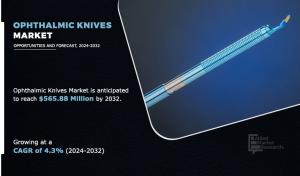Ophthalmic Knives Market Poised for Steady Growth Amid Rising Global Eye Surgeries
What are Ophthalmic Knives?
Ophthalmic knives are high-precision surgical instruments used to perform intricate incisions in eye surgeries. Typically crafted from stainless steel or diamond, these knives allow for minimal tissue trauma and enhanced healing. Their ultra-sharp blades are designed to cut delicate eye structures like the cornea, retina, and lens capsule with utmost precision—making them critical for successful outcomes in procedures such as cataract, glaucoma, and vitreoretinal surgeries.
Get a Sample Copy of this Report: https://www.alliedmarketresearch.com/request-sample/A10464
Market Drivers
Growing prevalence of eye disorders such as cataracts, glaucoma, and keratosis.
Surging geriatric population globally, a demographic more prone to eye diseases.
Increased preference for minimally invasive surgeries that require precise cutting tools.
Government initiatives to reduce visual impairment, especially in developing countries.
Technological advancements in blade design, enhancing sharpness, flexibility, and safety.
Key Restraints
High cost of advanced ophthalmic knives, limiting accessibility in low-income regions.
Availability of alternative treatments like laser-based surgeries.
Stringent regulatory approvals that delay product launches and market entry.
Market Opportunities
Emerging economies like India and China investing heavily in healthcare infrastructure.
Surge in outpatient surgical procedures, increasing demand in ambulatory surgical centers.
Development of patient-specific and customized knives, improving clinical outcomes.
Reusable and disposable innovations, offering both economic and hygienic benefits.
Segmental Insights
By Design
Slit Knives dominated in 2023 due to ease of handling, blunt tip design, and wide surgical utility.
Straight Knives are forecasted to grow at the fastest CAGR of 5.3% due to superior sharpness and single-hand retraction features.
By Product
Reusable Ophthalmic Knives held the largest share in 2023 thanks to their long lifespan and high-grade materials.
Disposable Knives are gaining traction, expected to grow fastest due to reduced infection risks, affordability, and no need for maintenance.
By Application
Cataract Surgery remained the dominant application in 2023, driven by increasing surgical volumes.
Glaucoma Surgery is set to register the highest CAGR, fueled by rising awareness and growing global glaucoma burden.
By End User
Hospitals led in market share in 2023 due to advanced infrastructure and high surgical volumes.
Others segment (including ASCs, eye clinics, and research institutions) will grow the fastest, thanks to the rise in outpatient procedures and innovative eye care solutions.
Regional Outlook
North America led the global market in 2023, owing to advanced healthcare infrastructure and high surgical adoption rates.
Asia-Pacific is expected to register the highest CAGR of 5.2% during the forecast period. This growth is spurred by rising healthcare investments, increasing cataract prevalence, and expansion of rural healthcare access.
Key Players
Major companies shaping the ophthalmic knives market include:
Amar Instruments
Bausch Health Companies Inc.
Core Surgical Ltd
Diamatrix Ltd.
Alcon, Inc.
Kanchan Eye Instruments
Mani, Inc.
Micromed International Pvt. Ltd.
Omni Lens Pvt Ltd.
Paramount Surgical Ltd.
These players are focusing on product innovation, strategic partnerships, and expansion in emerging markets to gain a competitive edge.
Conclusion
The ophthalmic knives market is witnessing sustained growth, propelled by rising surgical needs and evolving technologies. As the demand for precision and safety in eye surgeries continues to grow, ophthalmic knives will remain indispensable. Strategic investments in R&D, focus on affordable single-use products, and geographic expansion into emerging regions will be crucial for market players aiming to capitalize on this upward trend.
Enquire Before Buying: https://www.alliedmarketresearch.com/purchase-enquiry/A10464
David Correa
Allied Market Research
+ 1800-792-5285
email us here
Visit us on social media:
LinkedIn
Facebook
YouTube
X
Legal Disclaimer:
EIN Presswire provides this news content "as is" without warranty of any kind. We do not accept any responsibility or liability for the accuracy, content, images, videos, licenses, completeness, legality, or reliability of the information contained in this article. If you have any complaints or copyright issues related to this article, kindly contact the author above.
Karl Berger Takes Readers into a Desolate Pacific Outpost In His Gripping Novel, 'Clipperton'
A New Thanksgiving Tradition: Uplyft & Dayglo Presents to Host Parade Brunch From the Iconic Jazz at Lincoln Center
The Old Dutch Cupboard Shares Tips on Eating to Reduce Stress and Support Mood Health
Więcej ważnych informacji
 Jedynka Newserii
Jedynka Newserii

 Jedynka Newserii
Jedynka Newserii

Problemy społeczne

Ślązacy wciąż nie są uznani za mniejszość etniczną. Temat języka śląskiego wraca do debaty publicznej i prac parlamentarnych
W Polsce 600 tys. osób deklaruje narodowość śląską, a 460 tys. mówi po śląsku. Kwestia uznania etnolektu śląskiego za język regionalny od lat wzbudza żywe dyskusje. Zwolennicy zmiany statusu języka śląskiego najbliżej celu byli w 2024 roku, ale nowelizację ustawy o mniejszościach narodowych i etnicznych zablokowało prezydenckie weto. Ostatnio problem wybrzmiał podczas debaty w Parlamencie Europejskim, ale zdaniem Łukasza Kohuta z PO na forum UE również trudna jest walka o prawa mniejszości etnicznych i językowych.
Transport
Polacy z niejednoznacznymi opiniami na temat autonomicznych pojazdów. Wiedzą o korzyściach, ale zgłaszają też obawy

Polacy widzą w pojazdach autonomicznych szansę na poprawę bezpieczeństwa na drogach i zwiększenie mobilności osób starszych czy z niepełnosprawnościami. Jednocześnie rozwojowi technologii AV towarzyszą obawy, m.in. o utratę kontroli nad pojazdem czy o większą awaryjność niż w przypadku tradycyjnych aut – wynika z prowadzonych przez Łukasiewicz – PIMOT badań na temat akceptacji społecznej dla AV. Te obawy wskazują, że rozwojowi technologii powinna także towarzyszyć edukacja, zarówno kierowców, jak i pasażerów. Eksperci mówią także o konieczności transparentnego informowania o możliwościach i ograniczeniach AV.
Prawo
70 proc. Polaków planuje wyjazd na urlop w sezonie letnim 2025. Do łask wracają wakacje last minute

Ponad 70 proc. Polaków planuje wyjechać na urlop w sezonie letnim, czyli między końcem czerwca a końcem września – wynika z badania Polskiej Organizacji Turystycznej. 35 proc. zamierza wyjechać tylko raz, a 30 proc. – co najmniej dwa razy. Z grupy wyjeżdżających jedna trzecia wybierze się na wyjazd zagraniczny. Jak wskazuje Katarzyna Turosieńska z Polskiej Izby Turystyki, po kilku latach ponownie do łask wracają oferty last minute, a zagraniczne kierunki pozostają niezmienne – prym wiodą m.in. Grecja, Tunezja, Egipt czy Hiszpania.
Partner serwisu
Szkolenia

Akademia Newserii
Akademia Newserii to projekt, w ramach którego najlepsi polscy dziennikarze biznesowi, giełdowi oraz lifestylowi, a także szkoleniowcy z wieloletnim doświadczeniem dzielą się swoją wiedzą nt. pracy z mediami.


![Nestlé w Polsce podsumowuje wpływ na krajową gospodarkę. Firma wygenerowała 0,6 proc. polskiego PKB [DEPESZA]](https://www.newseria.pl/files/1097841585/fabryka-nesquik_1,w_85,r_png,_small.png)






.gif)

 |
| |
| |
|